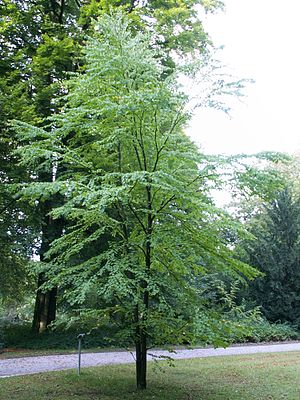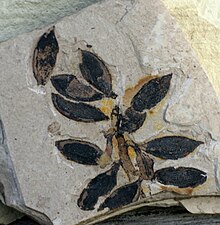Cake trees
| Cake trees | ||||||||||||
|---|---|---|---|---|---|---|---|---|---|---|---|---|

Japanese cake tree ( Cercidiphyllum japonicum ) |
||||||||||||
| Systematics | ||||||||||||
|
||||||||||||
| Scientific name of the family | ||||||||||||
| Cercidiphyllaceae | ||||||||||||
| Engl. | ||||||||||||
| Scientific name of the genus | ||||||||||||
| Cercidiphyllum | ||||||||||||
| Siebold & Zucc. |
The cake trees ( Cercidiphyllum ), also Katsurabäume called, are the only genus of the family of Cercidiphyllaceae within the order of the saxifrage-like (Saxifragales). The German common name cake trees comes from the fact that fallen, withered leaves develop a distinctive scent of (Leb-) cake. They are used as an ornamental plant and wood supplier.
description


Appearance and leaves
Cercidiphyllum species are deciduous, fast-growing trees that reach heights of up to 30 meters, sometimes up to 45 meters. The secondary growth in thickness is based on a conventional cambium ring . Vegetative long shoots and generative short shoots are formed. The sieve tube plastids are of the S type.
The opposite or seldom alternate leaves arranged on the long shoots are divided into a petiole and a leaf blade. The short shoots have only one leaf. The simple, dimorphic leaf blade is elliptical to broadly ovoid or heart to kidney-shaped and has a hand-shaped vein. The leaf margin is completely to finely sawn or notched. The stomata are anomocytic. The foliage turns intensely in autumn. The stipules fall out early.
Inflorescences and flowers
Before the leaves shoot, the bundled inflorescences are formed on short shoots in the common leaf nodes . The cake trees are mostly dioecious, separate sexes ( diocesan ), so there are female and male trees. The male inflorescences are very short and contain several flowers. The female inflorescences are short stalked and usually contain two to six, rarely up to eight flowers. The inflorescences are each over bracts .
The flowers have no bracts . The male flowers usually contain seven to thirteen stamens . The female flowers contain only one upper carpel with 15 to 30 ovules in two rows. The two-celled pollen grains have three apertures and are weakly colpat. The stylus ends in a long scar .
The pollination is carried by wind ( anemophily ).
Fruits and seeds
The follicles are bundled together. The winged flat seeds have oil-containing endosperm and a large, well-formed, chlorophyll-less embryo with two cotyledons ( cotyledons ).
Chromosome number
The number of chromosomes is n = 19.
ingredients
There are calcium oxalate accumulates, sometimes in Druze crystals. They contain cyanidin , ellagic acid and, in flavonols, kaempferol and quercetin .
Systematics, evolution and distribution

The genus Cercidiphyllum , like the genera Metasequoia and Ginkgo, is a living fossil . It is a very old genus that has only survived to this day with two species with disjoint areas in Asia. They have small areas in China, Taiwan, Korea and Japan. The genus was part of a " Tertiary China-Japan flora". There were related species in the tertiary in Europe and North America ( Holarctic ). Fossils of the family are known from the Paleocene and Eocene . Cercidiphyllum crenatum (Unger) RW Brown and Cercidiphyllum obtritum (Dawson) Wolfe & Wehr , for example, are extinct species whose leaves are found as fossils and whose pollen can be found in pollen analyzes from the Tertiary . The natural occurrences of the two recent species are in temperate areas.
The family name Cercidiphyllaceae was published in 1907 by Adolf Engler in the Syllabus of the Lectures on Specielle und Medicinisch-Pharmautische Botany , p. 126. The first description of the type genus Cercidiphyllum was made in 1846 by Philipp Franz von Siebold & Joseph Gerhard Zuccarini in treatises of Mathematics and Physics Classe Royal Bavarian Academy of Sciences , Volume 4, 3, S. 238. Type species is Cercidiphyllum japonicum Siebold & Zucc. They were given the botanical genus name Cercidiphyllum because the leaves look very similar to those of the Judas trees ( Cercis ).
The family Cercidiphyllaceae was formerly assigned to the orders Hamamelidales Wettstein and Fagales Engl. Molecular genetic studies show that it belongs to the Saxifragales order . The woody taxa Cercidiphyllaceae, Paeoniaceae , Altingiaceae , Hamamelidaceae and Daphniphyllaceae form a secured clade .
There are only two species in the genus Cercidiphyllum and thus in the family of the Cercidiphyllaceae:
- Japanese cake tree , Japanese katsura tree or gingerbread tree ( Cercidiphyllum japonicum Siebold & Zucc. Ex JJ Hoffm. & JH Schult. Bis ): The home is China, Taiwan , Korea and Japan.
- Magnificent Cake Tree , also called the Great Cake Tree or Large Katsura Tree ( Cercidiphyllum magnificum (Nakai) Nakai ). The homeland is the northern and central Honshū . It is much smaller and the leaves are wider and more heart-shaped, the bark is only cracked with age and the larger seeds have two wings.
Various cultivars are also known.
use
The cake trees are a very hard, light-colored wood that is a very valuable material for veneers .
Some varieties of Cercidiphyllum japonicum in particular are planted as ornamental trees in gardens and parks in the temperate zones of the world. In horticultural culture, varieties with different growth forms, for example with hanging branches and red leaves, were selected.
The trees are hardy in Central Europe. They don't like dry soils. The autumn color is particularly beautiful on acidic soils.
Astronym
The asteroid (8857) Cercidiphyllum was named after the Cercidiphyllaceae on April 2, 1999.
Web links
- The family of Cercidiphyllaceae in APWebsite. (Sections Description and Systematics)
- The Cercidiphyllaceae family at DELTA by L. Watson & MJ Dallwitz. (Section description)
literature
- Dezhi Fu & Peter K. Endress: Cercidiphyllaceae in der Flora of China , Volume 6, p. 126: same text online as the printed work , In: Wu Zhengyi, Peter H. Raven & Deyuan Hong (Eds.): Flora of China , Volume 6 - Caryophyllaceae through Lardizabalaceae , Science Press and Missouri Botanical Garden Press, Beijing and St. Louis, 2001. ISBN 1-930723-05-9 .
- MS Dosmann: Katsura: A review of Cercidiphyllum in cultivation and in the wild. In: The New Plantsman. 6, 1999, pp. 52-62.
Individual evidence
- ↑ Cercidiphyllum at Tropicos.org. Missouri Botanical Garden, St. Louis, accessed June 7, 2013.
- ↑ Cercidiphyllaceae in the Germplasm Resources Information Network (GRIN), USDA , ARS , National Genetic Resources Program. National Germplasm Resources Laboratory, Beltsville, Maryland. Retrieved June 7, 2013.
- ↑ a b c Rafaël Govaerts (Ed.): Cercidiphyllum. In: World Checklist of Selected Plant Families (WCSP) - The Board of Trustees of the Royal Botanic Gardens, Kew . Retrieved September 25, 2019.
- ↑ Michael Dirr: Dirr's Encyclopedia of Trees and Shrubs. Timber Press, 2011, ISBN 978-0-88192-901-0 , pp. 170 f.
- ↑ Minor Planet Circ. 34349




